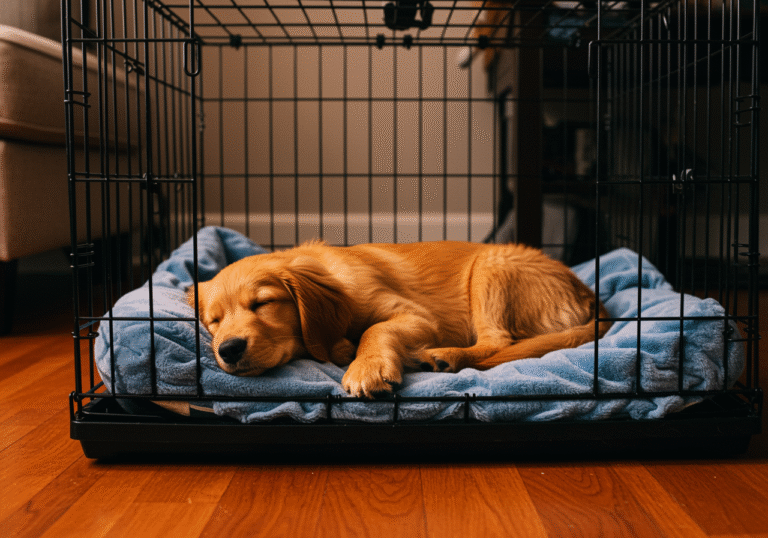Importance of Choosing the Right Location for Your Puppy’s Crate
Choosing the perfect location for your puppy’s crate is essential, as it significantly impacts their comfort, safety, and integration into your family life. A well-placed crate not only creates a welcoming environment but also assists in effective crate training. The right spot offers convenience for both pets and their owners while facilitating a smoother adaptation for furry newcomers. This strategic decision plays a crucial role in capitalizing on the numerous benefits associated with crate training, such as providing a secure space for rest and developing good behavior.
Crate training serves as a practical tool for housebreaking and managing a puppy’s anxiety during transition periods. Moreover, the crate acts as a safe haven, offering your puppy a sense of security when the environment around them becomes overwhelming. Whether it’s calming them after an energetic play session or helping them adjust to new surroundings, the correct location amplifies these benefits. Thus, determining where your puppy’s crate should be located requires thoughtful consideration of various factors.
Factors to Consider When Placing Your Puppy’s Crate
Accessibility and Ease of Access
Accessibility is paramount when deciding where to place your puppy’s crate. Place the crate in an area that is easy for you to reach throughout the day. This not only facilitates rapid response to your puppy’s needs but also enables frequent interaction, reinforcing their connection with you and the rest of the family. A central location in your home ensures that your puppy doesn’t feel isolated.
Family Activity Levels and Traffic Patterns
Consider the activity levels and traffic patterns in your home when choosing a crate location. A room that is too busy might disrupt your puppy’s sleep and cause unnecessary stress. Conversely, a space that’s too quiet may lead to feelings of isolation. Striking the right balance ensures that your puppy feels included but not overwhelmed by commotion.
Temperature and Climate Considerations
Temperature regulation is critical for your puppy’s comfort. Avoid placing the crate near heaters, air conditioning vents, or drafty areas. An environment that is too hot or cold is uncomfortable and might cause your puppy to resist the crate. Instead, opt for a room with a consistent climate to promote a healthy and amenable setting.
Away from Direct Sunlight and Drafts
Direct sunlight can significantly increase the temperature inside the crate, turning it into an unwelcoming space. Drafts, on the other hand, can make the crate too chilly. Placing the crate away from windows and exterior doors ensures a stable and cozy climate that is enticing for your puppy.
Ideal Rooms and Spaces for Crate Placement
Living Room: Pros and Cons
Positioning the crate in the living room has its benefits, such as ensuring the puppy is part of family activities, which aids in socialization. However, the hustle and bustle can sometimes lead to overstimulation. Implementing a routine to align with family activities might be necessary to ensure calm moments for rest.
Bedroom: Bonding and Nighttime Rest Benefits
Bedrooms are favorable for nurturing a sense of security, especially during nighttime rest. Proximity to you during the night helps in building a bond and eases nighttime anxiety. However, it’s important to teach boundaries as your puppy grows, maintaining the crate as a designated rest area.
Kitchen: Convenience and Supervision
The kitchen, often a hub of the home, offers convenient supervision and allows for easy monitoring of your puppy during meal preparation times. It provides an additional opportunity for interaction during daily routines, though care must be taken to avoid potential hazards, such as hot surfaces and sharp utensils.
Home Office: Balance Between Quiet and Company
The home office provides a quiet space that’s neither too isolated nor too chaotic, offering your puppy company while maintaining a peaceful environment. This setup benefits puppies sensitive to noise, allowing them to relax without being completely away from family presence.
Common Mistakes to Avoid
Isolating the Crate in Unused Rooms
Avoid placing the crate in unused or seldom-visited rooms. This can lead to feelings of isolation, making the puppy anxious and reluctant to use the crate. Integration into family life is essential to prevent feelings of loneliness.
Placing the Crate in Loud or Distracting Spaces
Overly loud or heavily-trafficked areas can be distressing for puppies. Environments that are too stimulating make it difficult for them to relax and can disrupt their sleep patterns, counteracting the benefits of crate training.
Changing Crate Locations Frequently
Consistency is key in crate training. Avoid moving the crate frequently, as this can cause confusion and anxiety for your puppy. Establishing a stable environment aids in routine development and gives your puppy a sense of security.
Frequently Asked Questions about Crate Placement
Can the Crate Be Moved Once Placed?
While it’s recommended to maintain a consistent location, minor adjustments might be necessary once you’ve observed your puppy’s response to the initial placement. Observing their comfort levels and responses will guide any necessary changes.
How Close Should the Crate Be to Family Activity?
The crate should be close enough to family activities to allow for inclusion and bonding but distant enough to offer peace. This balance will ensure your puppy is relaxed yet part of the family dynamics.
What if My Puppy Doesn’t Like the Initial Spot?
If your puppy shows discomfort or distress with the initial spot, it could be worthwhile to consider environmental factors that might be causing distress. Noise levels, temperature, or proximity to busy areas should be re-evaluated to enhance their comfort.
Tips for Helping Your Puppy Adjust to the Crate Location
Gradual Introduction Techniques
Introduce the crate gradually to create a positive association. Let your puppy explore the crate at their own pace, ensuring they don’t feel pressured. Spontaneous treats or favorite toys can motivate voluntary exploration.
Positive Reinforcement Strategies
Positive reinforcement encourages desirable behavior. Praise your puppy for calm behavior in and around the crate. Regularly rewarding them with treats when they enter the crate helps establish it as a welcoming and positive space.
Creating a Cozy and Inviting Crate Environment
Line the crate with a soft, comfortable mat or blanket. Including familiar toys and personal items with your scent can help your puppy feel at ease. The crate should emulate a cozy den-like environment that invites relaxation and rest.
Conclusion
Locating your puppy’s crate in the right space within your home is vital for their overall well-being and the success of their crate training. By considering factors such as accessibility, family activity, and environmental conditions, you create an inviting and secure space for your pet. Testing different setups and being flexible in adjustments will ensure that both you and your puppy are happy with the arrangement.
Additional Resources and References
For more insights on crate training and puppy behavior, consider exploring studies from renowned puppy training authorities. The American Kennel Club AKC provides valuable tips and guidelines on crate acclimatization and training techniques. Additionally, reach out to certified trainers for personalized support and advice. For enhancing crate comfort, high-quality products such as the Snoozer Cozy Cave can create a perfect napping environment for your furry friend.## Frequently Asked Questions about Crate Placement
What Are the Benefits of Choosing the Right Crate Location?
Choosing the right crate location is crucial for your puppy’s emotional and physical well-being. A well-placed crate helps in reducing anxiety and promoting better crate training adherence. It ensures that your puppy feels included in family activities without being overstimulated, fostering a secure environment for rest. This placement facilitates a smoother transition into the household, offering a stable and comforting space that can aid in housebreaking and behavior management.
Should My Puppy’s Crate Be Elevated or on the Floor?
The crate should typically be placed on a flat, stable surface to prevent tipping and to provide your puppy with a sense of stability. Elevating the crate can make the space feel less secure and increase the risk of accidents if the crate shifts or falls. Keeping the crate on the floor ensures easy access for your puppy and helps maintain a consistent environment, crucial for successful crate training.
Can Multiple Crate Locations Be Used Throughout the Day?
While consistency is generally recommended, using multiple crate locations is possible if necessary. Designate one primary crate area for nighttime use to maintain routine and consistency. During the day, if moving the crate is needed to maintain supervision—such as bringing the crate into the kitchen during meal preparation or the living room during family time—ensure that these changes do not disrupt the puppy’s emerging routine. Observing your puppy’s response will help you assess the suitability of alternating locations.
How Can I Make the Crate Appealing if My Puppy is Hesitant to Enter?
To entice your puppy into the crate, create a welcoming environment using positive reinforcement techniques. Place favorite toys or blankets inside, and use treats as incentives for entering. Slowly acclimate your puppy to the crate by leaving the door open so they can explore it at their own pace without feeling trapped. Implementing patience and gentle encouragement will help them associate the crate with comfort rather than confinement.
How Long Should My Puppy Spend in the Crate at Different Times of Day?
The time your puppy spends in the crate should vary based on age, energy level, and temperament. Puppies generally need frequent potty breaks, so keep initial crate sessions short—around 1 to 2 hours—to start. Gradually lengthen the time as they become more comfortable. Ensuring they have ample time out of the crate for exercise, play, and socialization is just as important for their well-rounded development and well-being.






